First there was a warm, comforting bowl of Sopa de frijoles (Bean Soup), followed by creamy dreamy Arroz con leche (Rice Pudding), then a savory batch of Guacamole so delicious you danced around the kitchen with a “green avocado laugh” printed on your face.
Sí, Amigos! It’s time to celebrate the fourth delectable book in Jorge Argueta’s bilingual Cooking Poem series, Tamalitos, illustrated by Domi (Groundwood Books, 2013). Estupendo!!
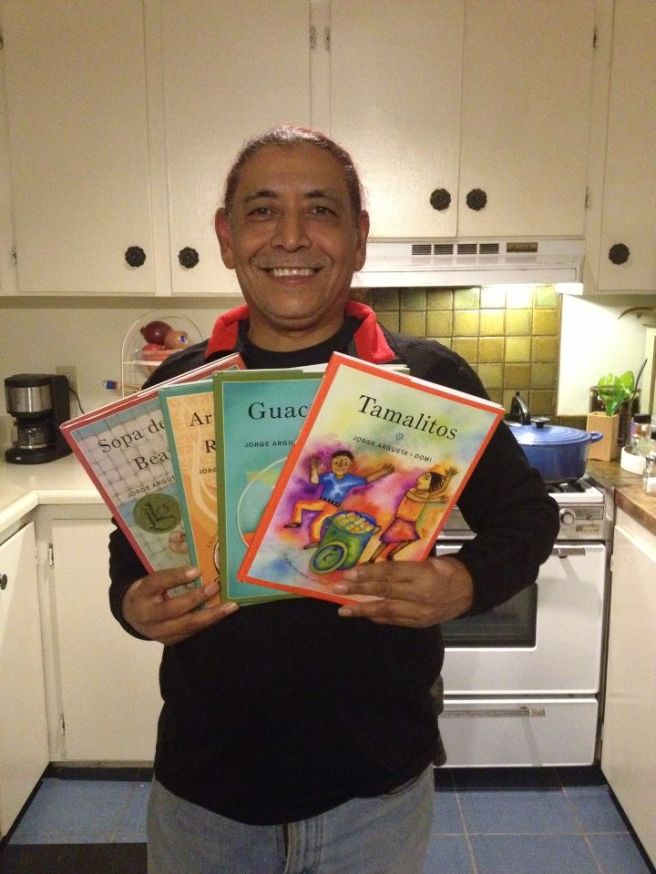
Most of you already know how much I adore these books, written by a poet who sees magic in each ingredient and every utensil and says, “the whole kitchen is a cooking poem.” *swoon*
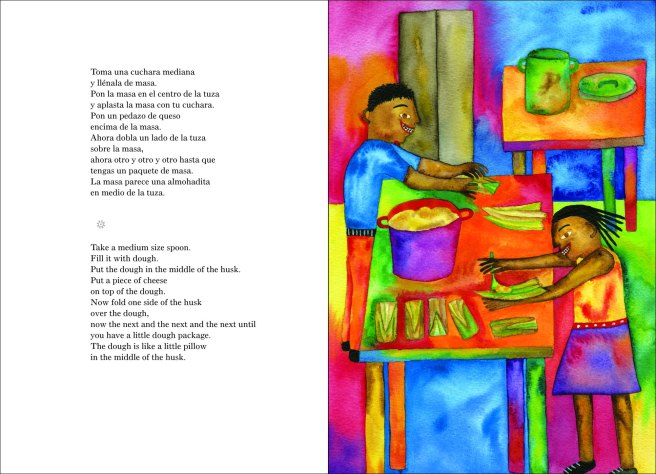
This time we read about a brother and sister making tamalitos, or “little tamales.” I want to hug myself just thinking about these mini corn masa and cheese-stuffed pillows wrapped in cornhusks (little pillows! a lot like dumplings!). As with the other cooking poems, there is reverence for Mother Earth, a lively, joyous total immersion in every step of the process, lots of sensory detail, and great anticipation at eating the final product and lovingly sharing it with the rest of the family.
Tamalitos begins with an homage to the corn plant — what it looks like, an appreciation of its many-colored kernels (“white, yellow, blue ones, purple, red and black ones/like a rainbow when it’s drizzling”) and a nod to its centuries-long cultural importance for the Mayans and other indigenous ancestors of Central America.
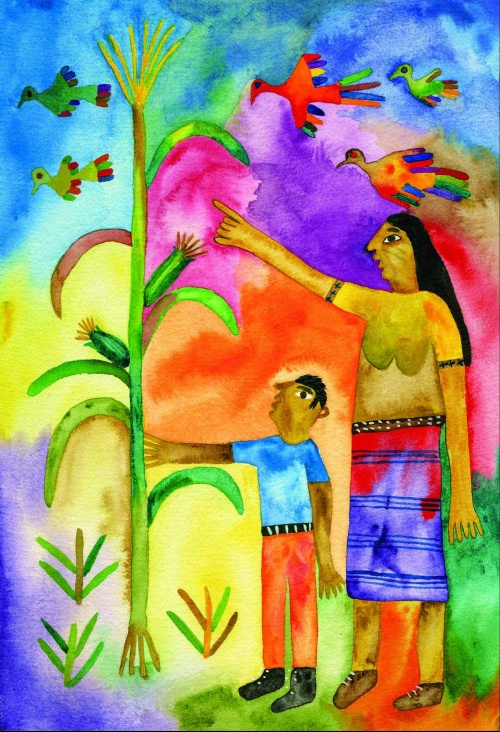
Cooking utensils and recipe ingredients are then gathered, corn husks are soaked, the dough is mixed and kneaded, pieces of cheese are added, and finally the little dough pillows are wrapped and steamed. All the while, there is drumming on pots and happy dancing (“the Nahua corn dance/and the Maya corn dance/and the Aztec dance/and the powwow dance/and the corn dance/of all the people of corn”), reminding us that cooking is so much more than just combining ingredients; it’s an activity that should be entered into with heart and soul to achieve the most satisfying results:
Measure four cups of flour
Add the lukewarm water,
little by little
When the water and flour are mixed, you have masa.
Stick your hands in the dough.
Move your hands
and your arms
and your whole body.
Feel the dough,
squeeze it,
stir it,
squish it,
knead it.Let your fingers
dance the corn dance
while you knead the dough.***
Mide con cuidado cuatro tazas de masa seca.
Ahora echa el agüta tibia sobre la masa seca,
poco a poquito.
Al mezclar el agua con la harina tienes masa.
Mete tus manos en la masa.
Menea tus manos
y tus brazos
y tu cuerpo.
Siente la masa,
apriétala,
remuévela,
estrújala,
amásala.Deja que tus dedos
bailen la danza del maíz
mientras amasas la masa.
Argueta’s rainbow of corn colors is amplified in every one of Domi’s vibrant, eye-popping watercolor spreads, ensuring that Tamalitos is as much a feast for the eyes as it is for the other senses. Argueta’s simple poetic language is always delightfully fresh and oh-so-lyrical with its playful childlike rhythm. I always enjoy reading the Spanish aloud, too:
The kitchen is a field of corn in flower.
There are flowers and clouds of corn,
the wind is corn,
the fire is corn.
I am dancing the dance of corn.
The smell of corn makes me fly.
I am singing the song of corn.
I am a corn cook.
The smell of corn makes me happy.
These tamalitos will be happy corn tamalitos!***
La cocina es una milpa en flor.
Hay flores y nubes de maíz,
el viento es maíz,
el fuego es maíz.
Estoy bailando la danza del maíz.
El olor del maíz me hace volar.
Estoy cantando el canto del maíz.
Soy un cocinero de maíz.
El olor del maíz me vuelve más feliz.
¡Estos tamalitos serán tamalitos de maíz feliz!
It’s such a pleasure to celebrate the poetry of food with someone like Jorge, who feels that “everything in the kitchen is pure poetry — sounds, smells, shapes, colors, forms.” With Tamalitos, he again lifts our spirits, whets our appetites, and serves up a totally satisfying recipe of masa and metaphor. A perfectly scrumptious choice for Poetry Month in April!
You are ready to relish the tamalitos.
You’ll see some steam
float off the tamalitos like a little sigh.Todo está listo
para saborear los tamalitos.
Verás el vapor saliendo de los tamalitos,
como un suspiro.
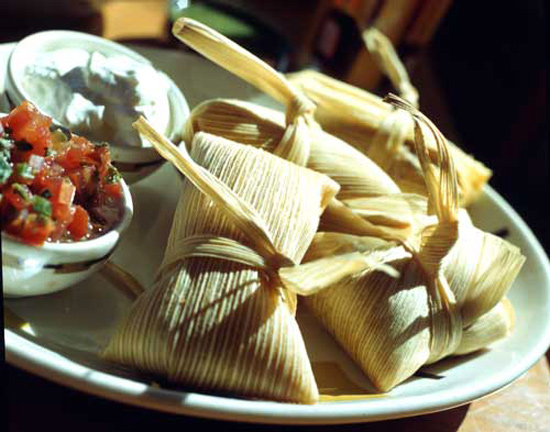
Mmmmmmm. Muy delicioso!
* * *
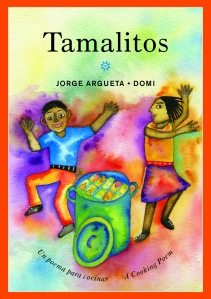 TAMALITOS: Un poema para cocinar/A Cooking Poem
TAMALITOS: Un poema para cocinar/A Cooking Poem
written by Jorge Argueta
illustrated by Domi
translated by Elisa Amado
published by Groundwood Books, 2013
Picture Book for ages 4-7, 32 pp.
*A Junior Library Guild Selection
On shelves: April 2013
* * *
♥ My review of Guacamole and interview with Jorge is here.
♥ My review of Arroz con leche/Rice Pudding is here.
♥ Learn more about Jorge’s wonderful books at his Official Website. Collect all four Cooking Poem books — you know you want to :)!
* * *
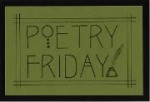 Jone is hosting today’s Roundup at Check It Out. Enjoy the full menu of delicious poetic offerings being served up in the blogosphere this week and enjoy your weekend!
Jone is hosting today’s Roundup at Check It Out. Enjoy the full menu of delicious poetic offerings being served up in the blogosphere this week and enjoy your weekend!
* * *
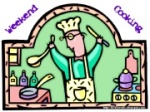 This post is also being linked to Beth Fish Read’s Weekend Cooking, where all are invited to share their food-related posts!
This post is also being linked to Beth Fish Read’s Weekend Cooking, where all are invited to share their food-related posts!
——————————————————
*Spreads from Tamalitos posted by permission of the publisher, text copyright © 2013 Jorge Argueta, illustrations © 2013 Domi, English translation © 2013 Elisa Amado, published by Groundwood Books. All rights reserved.
Copyright © 2013 Jama Rattigan of Jama’s Alphabet Soup. All rights reserved.

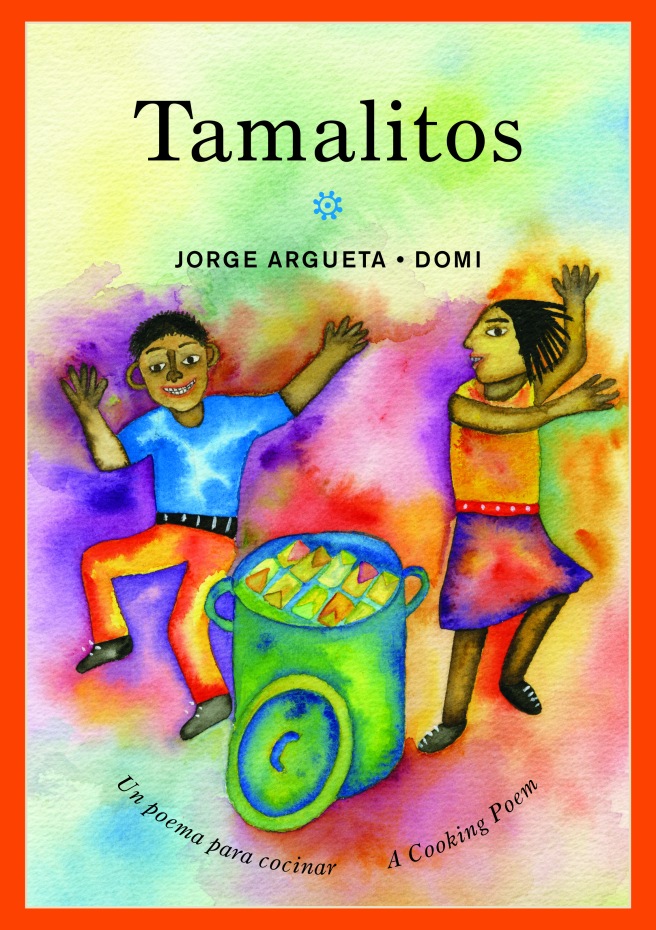
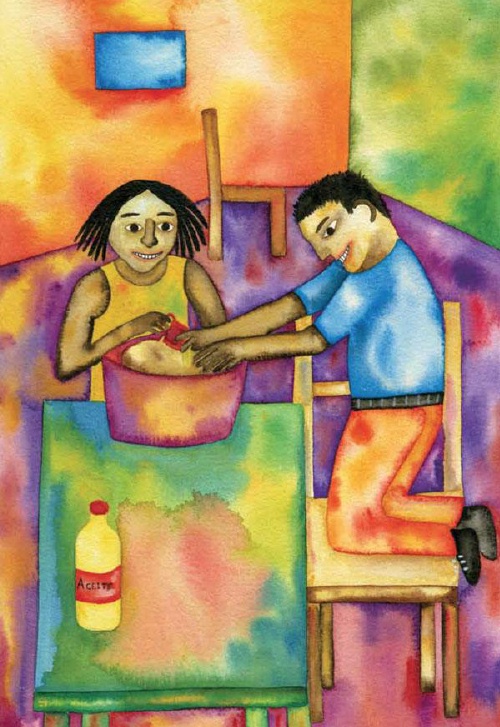

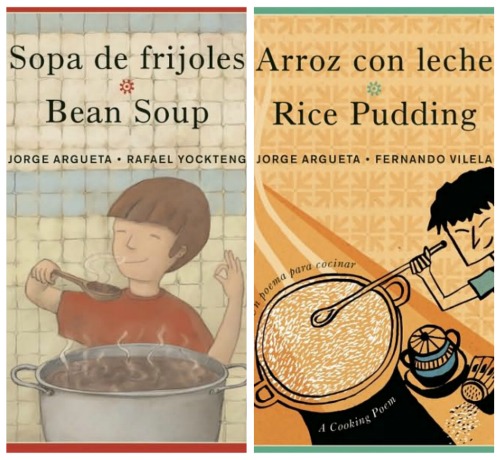
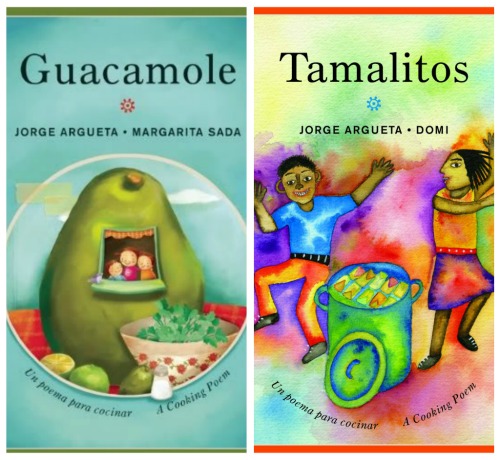
Delectable poems with mouth-watering illustrations! I love the bi-lingual aspect as well. Thanks for highlighting these fantastic books.
LikeLike
It’s a wonderful series, and I’m learning a little Spanish at the same time :).
LikeLike
Oh – that cover made me want to dance even before I read the selections you chose, Jama. What gorgeous art! And what delicious writing. This seems to be the perfect blend of reverence, play, and YUM. My stomach literally growled when reading this post. Congrats to Jorge on another winning title!
LikeLike
Definitely all the right ingredients combined to make another fabulous installment in the series. This one in particular has the market cornered on the joy of cooking. 🙂
LikeLike
I don’t think I’ve ever had a tamalito! It looks like all the books in the series have different illustrators. How interesting to get a fresh take each time! I think my favorite of these illustrations is the one of the children kneading the dough.
LikeLike
Yes, four different illustrators — all good choices. My fave illustration is the last one in this post — floating in the air with colorful clouds and corn — it seems to capture the essence and spirit of this book.
LikeLike
I love bilingual books – and such interesting illustrations! I must find this one! :–)
LikeLike
You’ll enjoy it! Nice folkloric feel to the illos in addition to the gorgeous colors. 🙂
LikeLike
Yum, yum, Jama. These books are new to me but not for long. Off to order each of them. Thanks for the highlights today.
LikeLike
So happy you decided to order them! They are quite the poetic feast :).
LikeLike
My mouth is watering for these books, Jama! I love the idea of “cooking poem” books! As mentioned by others, the illustrations are amazing as well! =)
LikeLike
I do love cooking/recipe poems — with this bilingual series, you always get a nice two-course meal. 🙂
LikeLike
What a gorgeous book. I love the watercolor images paired with the poems — so much life and joy in the food and in the pictures. It’s very cool that each book in this series has a different illustrator. Four different views of Latino culture.
LikeLike
I like the idea of different illustrators too, preserving the distinct flavors of each of the cooking poems.
LikeLike
Ooh, the art is as sumptuous as the cooking poems – and what a concept! I love the “little sigh” of steam. These are beautiful. 🙂
LikeLike
The “little sigh of steam” is my favorite part of the poem :). Each of these books is special in its own way.
LikeLike
This really brightened up my Friday! It’s a bit dark and gloomy here today.
LikeLike
Glad to offer some color and light to your day. Have a good (and hopefully sunnier) weekend. 🙂
LikeLike
Delicious!! I gotta look for this series!! Thanks for posting about it.
LikeLike
Do look for these; be prepared to get hungry though. 🙂
LikeLike
They sound fab! I’ll look out for them. Thanks Jama!
LikeLike
You’ll enjoy them, Catherine. Do you speak any Spanish?
LikeLike
Si un poco. A-level Spanish at night school. 🙂
LikeLike
Fantastic! I will definitely be getting this gorgeous book, Jama. Thanks so much for telling us about it.
LikeLike
Yay, happy to hear you’re getting this one, Amy!
LikeLike
“I want to hug myself just thinking about these mini corn masa and cheese-stuffed pillows wrapped in cornhusks”
I wanted to hug you too when I read that line. 🙂 Great review of a wonderful book!
LikeLike
Thanks, Julie. You’re quite huggable yourself :)!
LikeLike
The boys and I love tamales so much…
That book looks amazing.
LikeLike
Well, for a family of tamale lovers, this book is a must read.
LikeLike
Sumptuous…that’s. all I have to say about the art work, poems and your post, Jama!
LikeLike
Thanks so much — glad you enjoyed hearing about Tamalitos!!
LikeLike
Such colors!
LikeLike
Love them! 🙂
LikeLike
I would buy these books just for the illustrations. Add the kitchen poetry and the food … well, I too am swooning. I had forgotten about these books (which I learned about through you!) — it’s time I had my own copies.
LikeLike
Yes, get them soon — Jorge is currently working on the next book about salsa!
LikeLike
Oh, man…you’re making me hungry!! (And that’s different from other weeks…how???) 🙂
LikeLike
Hunger is a good thing, my little tamalitos :).
LikeLike
The illustrations are so beautiful, would be wonderful to have a few framed for the kitchen! These books are wonderful, Jama. Love “The kitchen is a field of corn in flower.” I can think of a number of people who will love the book!
LikeLike
You’re right — framed illustrations would really cheer up any kitchen. This is my first experience with Domi — I need to look for more of her work.
LikeLike
I love the colorful illustrations, and the tamalitos look tasty.
LikeLike
It’s nice to be reminded that recipes turn out best with the added “secret” ingredient of love. 🙂
LikeLike
What a charming series! I love the colorful illustrations to go along with those great poems.
LikeLike
They’re really delightful books!
LikeLike
The colours in those pictures are just fantastic – I’d hang them on the wall as art!
LikeLike
I agree — perhaps we can convince Domi to sell prints :).
LikeLike
How nice! They look like beautiful books. One of my favorite books to read to my kids when they were little was Abuela by Arthur Dorros. The illustrations reminded me of it a little, mostly the bright colors, probably.
LikeLike
Yes, a classic! I want to reread Abuela now that you mentioned it :).
LikeLike
LOVE the art work!!
LikeLike
Me too!
LikeLike
Hi Jama,
What a delightful collection of books, even though I don’t have any children, or know any which are still in that age group, I can appreciate them on so many levels.
The fact that they are bilingual, the recipes are explained in a way that children can understand for themselves, the poetry offers a welcoming structure to page to help hold the interest of a child and last but not least those amazing, eye-catching illustrations which help to explain the written story.
An invaluable collection of children’s books and an interesting post, thank you.
Yvonne
LikeLike
Thanks for the lovely comment, Yvonne. Your observations are all spot on, spoken like a true book lover :)!
LikeLike
Oh this book looks delicious! Definitely on my to-read list. Thanks for introducing it.
LikeLike
You will enjoy it!!
LikeLike
Yum! This series IS right up your alley! Thanks for sharing it.
LikeLike
You know me too well, Ruth. 🙂
LikeLike
I adore Domi’s vivid, richly colored illustrations.
LikeLike
Me too! Thanks for dropping by, Angela :).
LikeLike